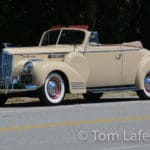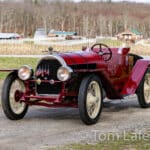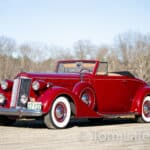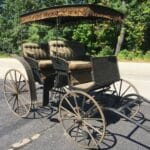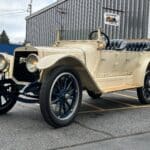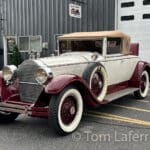Author Archives for Tom Laferriere
- April 8, 2024
- Not categorized
- Posted by Tom Laferriere
- No comments yet
Chassis No. 1025
Body No. 01033
Engine No. 2647
6,002 cc side valve inline eight cylinder engine, 140hp, 3-speed manual transmission, 4-wheel hydraulic drum brakes, Coil spring independent front suspension, live rear axle.
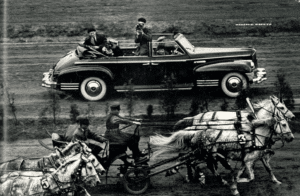
It looks like a 1942 Packard with some idiosyncratic features. It isn’t, despite oral history that had Franklin Roosevelt induce Packard to send its blueprints and production dies to the Soviet Union as a gift to Joseph Vissarionovich Stalin during World War II to play up to Stalin’s love for Packards.
1958 Bentley S1 Long Wheelbase Saloon
Coachwork by James Young- April 1, 2024
- Not categorized
- Posted by Tom Laferriere
- No comments yet
Coachwork by James Young Ltd.
Chassis Number ALB 20
Engine Number B19A
“The intention is that the gentleman should be chauffeur-driven to and from appointments during the week, but should use the car as a normal family saloon (sedan) at the weekends and holiday times.” (Autocar Magazine)
Conscious that there was a small but select group of owner-drivers who found the standard wheelbase Silver Cloud/ Bentley S1 chassis (be it in Standard Steel Saloon or coachbuilt guise) somewhat lacking in space and presence, Crewe introduced a lengthened variant in Autumn 1957. Given that their “Bentley S” chassis had been a modular design (and indeed would underpin everything from the Cloud/ S-series to phantom V/VI, the four-and-a-half-inch stretch that this entailed was easily accommodated. Equipped with the same coil sprung independent front suspension, live rear axle, and hydraulic drum brakes as its lesser siblings, the LWB chassis also [...]
1941 Packard 160 Convertible Coupe Deluxe
Great Proven Tour Car- April 1, 2024
- Not categorized
- Posted by Tom Laferriere
- No comments yet
Vehicle No. DE-1479-2015
Engine No. D500663 (One-Sixty: D-500001->504550)
Series 1903. 160 hp, 356 cu. in. L-head inline eight-cylinder engine, three-speed manual transmission, independent front suspension with coil springs, live rear axle with semi-elliptic leaf springs, and four-wheel hydraulic drum brakes. Wheelbase: 127 in.
For 1941’s Nineteenth Series models, Packard extensively modernized the car’s styling, lengthening all bodies by five inches, moving radiators further forward, and blending the headlamps and parking lights smoothly into the fenders. Outside of the limited-production “Darrins,” the most costly convertibles were found in the Super Eight One Sixty line, including a sleek convertible coupe with an excellent power-to-weight ratio thanks to its nine-main-bearing, 356-cubic-inch engine.
Importantly this example retains the original firewall vehicle number tag, identifying it as a genuine One Sixty Convertible Coupe DE, delivered by the Packard Motor Car Company of New York on April 26, 1941. Further, it is desirably outfitted [...]
1947 Cadillac Model 62 Convertible
AACA National Award Winner- March 20, 2024
- Not categorized
- Posted by Tom Laferriere
- No comments yet
Chassis No. 8423605
In August 1945 Cadillac phased out World War II production of tanks, self-propelled gun carriers and carloads of precision parts for Allison aircraft engines and in just two months resumed production of civilian cars for a starved market. Their design was carried over from the truncated 1942 year but that year had marked an advanced and distinctive styling change from Harley Earl and Bill Mitchell.
Elongated ovoid fenders extended back into the doors and were mimicked in the rear fenders that accentuated the Cadillacs’ length, giving it futuristic aerodynamic styling that continued in skirted rear fenders. It translated well to postwar sensibilities. 1946 and 1947 Cadillacs continued the design theme and Cadillac sold every car it could build to a car-starved market.
This 1947 Cadillac Series 62 Convertible Coupe has received a thorough, meticulous restoration to like new condition. Its Lotus Cream paint is a tribute [...]
- March 13, 2024
- Not categorized
- Posted by Tom Laferriere
- No comments yet
Chassis No. 66A604
Engine No. 66-A-604
70 bhp, 332 cu. in. L-head V-8, three-speed manual transmission, solid front axle, semi-elliptic leaf spring suspension, and rear-wheel drum brakes. Wheelbase: 128 in.
Vintage speedsters, a labor of love for enthusiasts, have emerged from various chassis, but this particular masterpiece stands out as one of the rare specimens born from a Peerless base. Peerless, hailing from Cleveland, Ohio, earned its place among the prestigious “Three P’s” of American motoring, alongside the iconic Packard and Pierce-Arrow. Revered for its steadfast engineering, Peerless garnered a reputation for enduring reliability during its heyday.
Ivan Jones and his late wife, Audrey, dedicated the late 1970s to sourcing parts from every corner of the country for their dream car. Residents of Littleton, Colorado, the couple epitomized true craftsmanship and automotive passion. Drawing inspiration from the speedsters of yore produced by Peerless in the early [...]
1937 Packard Twelve Convertible Coupe
Provenance - Sorted - Ready- March 12, 2024
- Not categorized
- Posted by Tom Laferriere
- No comments yet
175 BHP, 473 cu. in. L-head V-12 engine, three-speed selective synchromesh manual transmission, independent front suspension with coil springs, rear live axle with semi-elliptical leaf springs, four-wheel vacuum-assisted hydraulic drum brakes.
- Fitted with its original Packard Vehicle Number plate
- An impressive and nicely sorted example of Packard’s Twelve-Cylinder Coupe Roadster
- Accompanied by restoration and service invoices totaling $162,000 from several noted specialists
- Engine rebuild completed in 2018 by Parker’s Packards
Vehicle No. 1039-236
Motor No. 906255AA
Following the success of the V-12 Twin Six model offering from 1916 to 1923, Packard reintroduced a freshly-engineered Twin Six in 1932. In order to distinguish the significant engineering differences from the earlier Twin Six, the model was known as the Twelve from 1933 onward.
The Packard Twelve of 1937 is highly desired by collectors and driving enthusiasts for its wonderful styling which includes a wonderful combination of stylistic and mechanical [...]
- March 8, 2024
- Not categorized
- Posted by Tom Laferriere
- No comments yet
TWO SEAT SURREY – Hassett & Hodge, Amesbury Mass, ca 1890-1915, fine original example of a fringed canopy light duty four passenger surrey, original yellow striped green paint, fine upholstered seats, shaped fenders and dash, nickel plated axle nuts and painted canvas floor covers. 92″ high, 66″ wide, 15″ long. Fine all original condition with shafts. A preservationists dream!
1914 Lozier Model 77 Five Passenger Touring
Big Powerful Brass Era Car- December 3, 2023
- Not categorized
- Posted by Tom Laferriere
- No comments yet
1914 Lozier Type 77 Five-Passenger Touring
Chassis No. 8215
Engine No. 8207
36.06 rated hp, 389 cu in. L-head inline six-cylinder engine, three-speed manual transmission with reverse, front and rear semi-elliptical leaf suspension, and rear-wheel mechanical drum brakes. Wheelbase: 127½ in.
Famously advertised as “The Quality Car for Quality People,” the Lozier automobile was introduced in 1900 by the prominent Plattsburgh, New York industrialist, Henry A. Lozier, a former sewing machine and bicycle automobile who had later turned quite profitably to marine engines. Following the senior Lozier’s passing in 1903, his son Harry succeeded and in short order Lozier began turning out robustly constructed, beautifully engineered automobiles that were among the very finest in the world. Designed by the brilliant John Perrin, Lozier cars were typically quite powerful and proved very successful in competition; it was a Lozier that controversially finished second (or did it?) in the first Indianapolis 500, and another [...]
- November 30, 2023
- Not categorized
- Posted by Tom Laferriere
- No comments yet
Vehicle No. 228330
Engine No. 226440A
1928 was a watershed year for Packard, ending production of its successful high production Six in favor of going all-in with its prestigious and long-lived inline Eight.
The demise of the Six in mid-1928 brought new features to the Fourth Series Eight with an innovative oiling system that when the choke was applied sprayed a film of oil on the cylinder walls to lubricate the cylinders when cold and during warmup and an oil filter, also new for 1928. And as the Six was phased out a new lower cost line of Standard Eights was introduced priced $500-$600 below the range topping Custom Eight.
The Custom Eight was easily distinguished from its Standard Eight counterpart by dual side-mounted spares (the Standard had a single rear-mounted spare) and hood side vent doors instead of [...]


